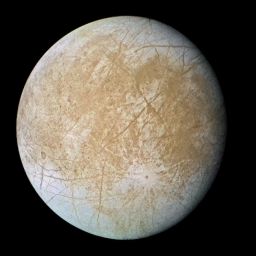Emily Lakdawalla • Dec 24, 2007
Another blast from Galileo's past: Europa
Here's another set of Ted Stryk's newly reprocessed versions of Galileo's global shots of Jupiter's icy moons (see my previous post on his Callisto and Amalthea images). These are of Europa, the smallest of the Galilean moons, whose icy surface is fractured and grooved and bumped by internally generated forces. The crisscrossing patterns of the fractures and grooves are an intensely interesting puzzle to geologists trying to figure out what they say about the history of Europa's surface.
Galileo got several global views, but as I was uploading them into the image database, trying to figure out what features they showed, I realized that Galileo mostly viewed Europa's trailing hemisphere, the hemisphere that faces backwards along Europa's orbit. This hemisphere has a reddish stain, and the red color is particularly concentrated along some of Europa's long ridges. It's an interesting part of Europa to be sure, but it's a shame that there isn't a good view of the opposite hemisphere. More stuff for a followup Jupiter mission to do! (Though it occurs to me I really need to dig into the Voyager data set to see what there is on the leading hemisphere -- something I don't have time to do on Christmas Eve.) Here's two nearly full-phase views centered on that trailing hemisphere.
The Time is Now.
As a Planetary Defender, you’re part of our mission to decrease the risk of Earth being hit by an asteroid or comet.
Donate Today

 Explore Worlds
Explore Worlds Find Life
Find Life Defend Earth
Defend Earth


